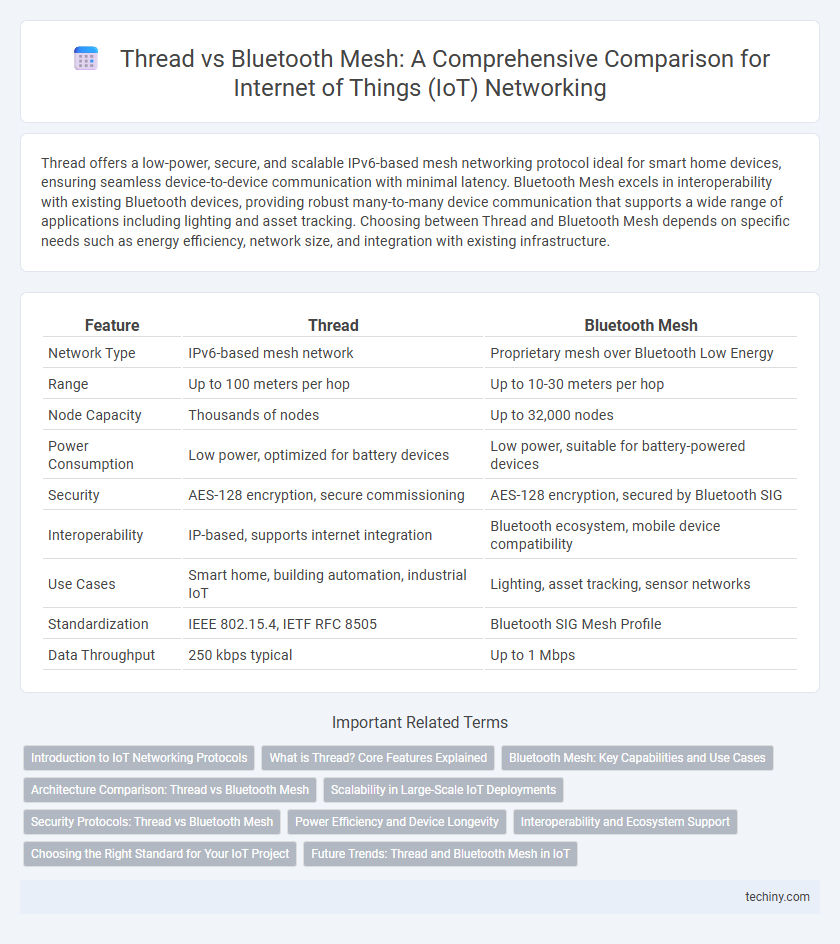Thread offers a low-power, secure, and scalable IPv6-based mesh networking protocol ideal for smart home devices, ensuring seamless device-to-device communication with minimal latency. Bluetooth Mesh excels in interoperability with existing Bluetooth devices, providing robust many-to-many device communication that supports a wide range of applications including lighting and asset tracking. Choosing between Thread and Bluetooth Mesh depends on specific needs such as energy efficiency, network size, and integration with existing infrastructure.
Table of Comparison
| Feature | Thread | Bluetooth Mesh |
|---|---|---|
| Network Type | IPv6-based mesh network | Proprietary mesh over Bluetooth Low Energy |
| Range | Up to 100 meters per hop | Up to 10-30 meters per hop |
| Node Capacity | Thousands of nodes | Up to 32,000 nodes |
| Power Consumption | Low power, optimized for battery devices | Low power, suitable for battery-powered devices |
| Security | AES-128 encryption, secure commissioning | AES-128 encryption, secured by Bluetooth SIG |
| Interoperability | IP-based, supports internet integration | Bluetooth ecosystem, mobile device compatibility |
| Use Cases | Smart home, building automation, industrial IoT | Lighting, asset tracking, sensor networks |
| Standardization | IEEE 802.15.4, IETF RFC 8505 | Bluetooth SIG Mesh Profile |
| Data Throughput | 250 kbps typical | Up to 1 Mbps |
Introduction to IoT Networking Protocols
Thread and Bluetooth Mesh are prominent IoT networking protocols designed for reliable device connectivity. Thread offers low-power, IPv6-based mesh networking with secure, scalable, and self-healing capabilities ideal for smart home applications. Bluetooth Mesh excels in device interoperability and vast network support, leveraging the widespread use of Bluetooth technology for large-scale sensor and control networks.
What is Thread? Core Features Explained
Thread is a low-power, wireless mesh networking protocol designed specifically for Internet of Things (IoT) devices, enabling secure and reliable device-to-device communication. Core features include IPv6 support for direct internet connectivity, low latency, self-healing mesh topology, and robust security with AES encryption. Thread's scalability and power efficiency make it ideal for smart home applications and large-scale sensor networks.
Bluetooth Mesh: Key Capabilities and Use Cases
Bluetooth Mesh enables large-scale device networks through its robust many-to-many communication model, supporting up to 32,767 nodes for extensive IoT deployments. It excels in applications like smart lighting, asset tracking, and building automation by providing reliable, secure, and low-latency connections with seamless device interoperability. Enhanced features such as message relay, encryption, and managed flooding ensure stable performance in complex environments where scalability and responsiveness are critical.
Architecture Comparison: Thread vs Bluetooth Mesh
Thread employs a decentralized, IPv6-based mesh network architecture designed for low-power, secure, and scalable device communication in smart homes and industrial IoT. Bluetooth Mesh operates on a managed flooding architecture using Bluetooth Low Energy (BLE), emphasizing compatibility with mobile devices and simpler device provisioning. Thread's native IP support facilitates direct internet connectivity and interoperability, whereas Bluetooth Mesh relies on proxy nodes and gateways to bridge to IP networks, influencing latency and network control.
Scalability in Large-Scale IoT Deployments
Thread offers superior scalability for large-scale IoT deployments by supporting thousands of devices in a self-healing, low-latency mesh network optimized for low power consumption and IPv6 integration. Bluetooth Mesh, while robust for smaller networks, typically supports fewer nodes and faces higher latency challenges as device count scales, limiting its effectiveness in extensive smart home or industrial environments. The IPv6 compatibility and efficient routing protocols of Thread make it the preferred choice for expansive, scalable IoT ecosystems requiring secure and reliable connectivity.
Security Protocols: Thread vs Bluetooth Mesh
Thread employs AES-128 encryption at the network and application layers, leveraging IEEE 802.15.4 security standards to ensure secure device authentication and data confidentiality. Bluetooth Mesh uses AES-128 CCM cryptography with Secure Network Beaconing and device key management for encrypted communication and message integrity. Both protocols incorporate robust security mechanisms, but Thread emphasizes IP-based secure networking, while Bluetooth Mesh focuses on secure multicast messaging for scalable device interactions.
Power Efficiency and Device Longevity
Thread technology offers superior power efficiency compared to Bluetooth Mesh by utilizing a low-power, IPv6-based mesh network protocol that allows devices to remain in sleep mode longer, significantly extending battery life. Bluetooth Mesh, while capable of supporting large-scale device networks, requires more frequent communication that can lead to higher energy consumption and reduced device longevity. Device longevity in IoT deployments benefits from Thread's ability to optimize power usage through asynchronous communication and minimal retransmissions, making it ideal for battery-powered sensors and devices.
Interoperability and Ecosystem Support
Thread offers superior interoperability with IP-based networks, enabling seamless integration with existing internet infrastructure and smart home devices, while Bluetooth Mesh relies on a proprietary protocol limiting direct IP communication. The Thread ecosystem benefits from strong backing by the Connectivity Standards Alliance, ensuring broad industry support and compatibility across diverse manufacturers. In contrast, Bluetooth Mesh enjoys widespread adoption due to Bluetooth's global presence but often faces challenges in cross-vendor interoperability and scalability within complex IoT systems.
Choosing the Right Standard for Your IoT Project
Thread offers low-power, IPv6-based networking ideal for scalable, secure IoT deployments with native internet compatibility, while Bluetooth Mesh provides widespread device support and robust device-to-device communication suited for short-range applications. Assessing network size, power consumption, range requirements, and interoperability needs helps determine the optimal protocol for your IoT project. Selecting the right standard enhances device performance, simplifies integration, and future-proofs connectivity in smart environments.
Future Trends: Thread and Bluetooth Mesh in IoT
Thread and Bluetooth Mesh are shaping the future of IoT connectivity by enabling scalable, secure, and low-power networks suitable for smart homes and industrial applications. Thread's IP-based architecture facilitates seamless integration with existing internet protocols, enhancing device interoperability and cloud connectivity. Bluetooth Mesh, leveraging widespread Bluetooth LE adoption, focuses on robust device-to-device communication with efficient multicast support, driving innovation in large-scale sensor networks and asset tracking.
Thread vs Bluetooth Mesh Infographic

 techiny.com
techiny.com